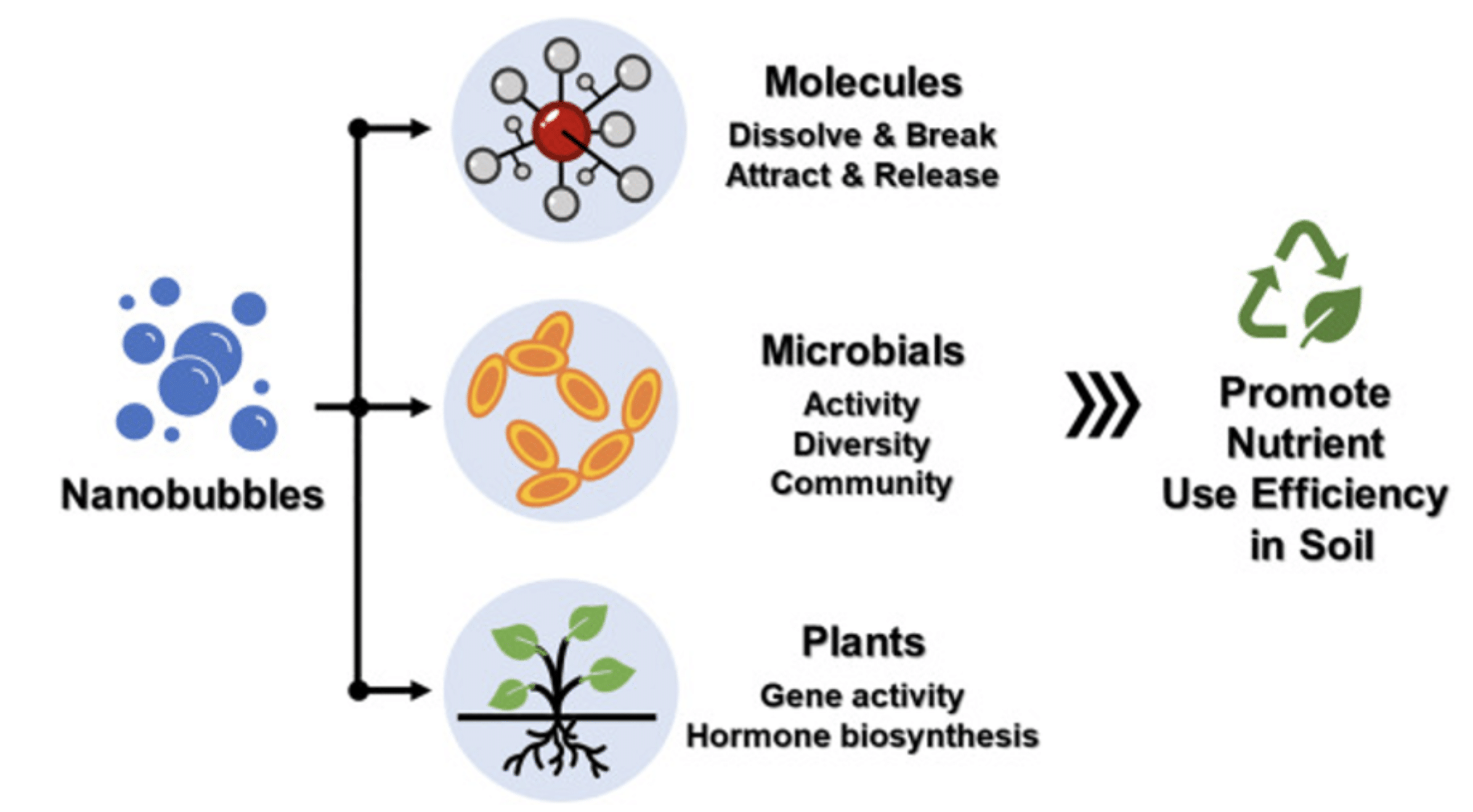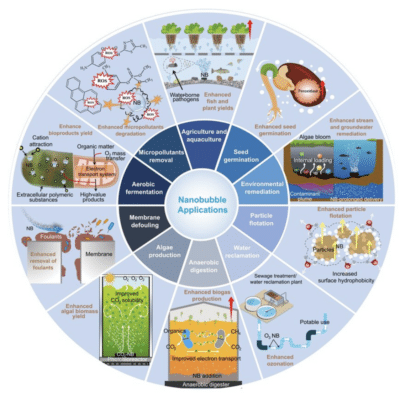In today’s age, cultivation research and technology are progressing at unprecedented speeds, resulting in a constant agricultural evolution. Among these shifts is the use of nanobubble technology in cannabis cultivation. Although this emerging technology deals with microscopic components, its impact is anything but small. Its power lies in its unique ability to improve water and nutrient uptake, optimize growing conditions, and enhance the overall vitality of cannabis plants, making it a critical area of focus for cultivators hoping to improve their crop’s growth, yield, and quality.
Understanding Ultrafine or Nanobubbles
So, what exactly are nanobubbles? Essentially, a bubble is a pocket of gas or air encapsulated within a liquid medium. Bubbles are categorized based on their size: regular bubbles (visible to the naked eye), microbubbles (visible as a milky solution), and ultrafine or nanobubbles (invisible to the naked eye and less than 1 micron in size). Microbubbles, formed from air or gas introduced into a liquid carrier phase, exhibit unique properties, including prolonged stability in the liquid for up to six months under specific conditions. This stability stems from their negatively charged surface and high gas solubility.
Nanobubbles surpass their larger counterparts primarily in size, stability, and behavior. Due to their highly pressurized and electrically charged nature, these ultrafine bubbles can remain suspended in a liquid for an extended duration (beyond six months). Their slow ascension and inability to scatter visible light due to their minute size render the water solution transparent. The highlight of nanobubbles lies in their ability to dissolve water and nitrogen when they burst, resulting in the formation of sanitizing hydroxyl radicals.
How Are Nanobubbles Formed?
The process of creating nanobubbles involves a high-pressure pump, water, and air or gas. The air is broken into tiny bubbles through turbulent motion under high pressure, leading to the formation of microbubbles. These microbubbles, subjected to further mechanical force or broken down due to their extreme internal pressure, eventually evolve into nanobubbles. For cannabis cultivation, these nanobubbles infused in irrigation water can dramatically enhance the plant’s oxygen and nutrient uptake, leading to healthier plants and improved yields. As a result, nanobubble technology holds immense promise as a tool for optimizing cannabis cultivation practices.
(Wang et al., 2021)
Nanobubbles in Controlled Environment Agriculture (CEA)
Cultivating cannabis is a complex process that requires precise control over various factors such as light, temperature, and nutrients. In Controlled Environment Agriculture (CEA), recent research has shown the beneficial effects of Oxygen Nanobubbles (ONB) in making the process more efficient. ONBs have been found to accelerate seed germination by 10%, plant growth by 30-50%, and even increase peroxidase activities in tomato leaves by 500-1000%, thus promoting cell proliferation and plant growth [1]. A case study conducted by Earthwise Global revealed that the implementation of nanobubbles resulted in a 20% increase in wet weight and a 15% increase in cured dry weight compared to the control [2]. With such remarkable improvements in growth and yield, it’s clear that integrating nanobubbles into CEA holds great promise for enhancing cannabis cultivation efficiency and productivity.
(Macelino et al., 2022)
Cost Implications of Nanobubble Technology
Before integrating nanobubble technology into the cultivation process, various cost factors need to be considered:
- Capital Expenditure: The transition to nanobubble technology in agriculture requires specific equipment, such as nanobubble generators or infusion mechanisms, each of which can vary in size, capacity, and complexity. The total expenditure on equipment hinges on several aspects, including the essential flow rate, pressure requirements, and desired quality control features.
- Operational Expenditure: Nanobubble systems depend on a consistent power supply to generate and sustain nanobubbles. This means energy consumption forms a critical component of operational cost projections. Additionally, regular upkeep and servicing of the system are integral for its longevity, further adding to your running costs.
- Water Resource Considerations: Access to a stable water supply is essential to operate nanobubble technology. This may involve establishing a new water supply infrastructure or modifying the existing irrigation framework. The costs of securing or treating water could pose a significant challenge to the overall operational expenses.
- Installation and Integration Expenditure: Integrating nanobubble technology into pre-existing agricultural systems may require certain adjustments. This can bring about additional costs associated with labor for the installation process, alterations in plumbing, and harmonizing the nanobubble system with existing infrastructure.
- Expertise and Training Costs: The effective utilization of nanobubble technology requires a certain level of proficiency and expertise. The cost of training personnel or recruiting specialists to operate and maintain the technology can contribute to the overall expenditure.
- Research and Development Costs: Those considering the application of innovative or advanced nanobubble technologies may need to budget for research and development costs related to fine-tuning the system to suit specific agricultural needs.
- Investment Returns: While nanobubble technology can offer significant benefits, such as better crop yields and water efficiency, it’s critical to evaluate the return on investment. Factors to consider in this analysis include the anticipated increase in productivity, cost savings in other operational areas (for instance, reduction in fertilizer utilization), and the potential market value of the upgraded agricultural produce.
Benefits of Nanobubbles in Cannabis Cultivation
The use of nanobubbles in cannabis cultivation in a Controlled Environment Agriculture (CEA) setup offers numerous benefits:
- Enhanced Oxygen Levels: By improving air-to-water ratios, nanobubbles help foster an environment that discourages the growth of detrimental fungi and promotes beneficial microbial activity.
- Water Treatment: The presence of nanobubbles can improve water quality and prevent harmful microbiology. This is pivotal in maintaining the health and vitality of cannabis plants and minimizing the incidence of plant diseases.
- Nutrient Uptake/Delivery: Nanobubbles aid in boosting aeration, which in turn stimulates root growth and enhances the availability and absorption of nutrients.
- Water Circularity: Nanobubble technology promotes water and waste efficiency, resulting in better resource conservation, higher yields, and increased profitability. In fact, nanobubbles can lead to a 20% increase in irrigation efficiency [2].
- Respiration: Nanobubbles facilitate the efficient exchanges of gases, which aids in plant respiration and recovery and improves overall plant performance.
- Integrated Pest Management: Offering a proactive approach to IPM, nanobubbles are an effective tool against root zone and leaf pathogens.
- Elevation Solutions: At higher altitudes, maintaining plant vitality can be challenging. Nanobubbles can provide a solution by maintaining optimal oxygen levels and nutrient availability.
- Yield Increase: Nanobubble technology offers enhanced nutrient uptake, plant vitality, and CO2 assimilation, all of which translate into higher yields.
- Eco-friendly: Using nanobubbles is chemical-free, sustainable, and promotes a safer environment for employees.
- Impacts on Root Growth, Plant Morphology, and Phenotypic Expression: Nanobubbles contribute to faster rooting and shorter cycle times, promoting efficient growth and plant morphology. They also influence the phenotypic expression of cannabis plants, potentially leading to desirable traits in the final product. This can translate into products of higher market value.
There are a handful of great nanobubble technology providers who are effectively serving the cannabis space. Considering the inconsistency of nanobubble results, case studies, and prescriptive solutions, it is important to take a researched approach before investing in this technology. Reach out and see which one is a good fit for your budget, business goals, and personality.
- Earthwise Global – https://earthwiseglobal.com/technology
- Moleaer – https://www.moleaer.com/
- Eden Water Technologies – https://edenwatertech.com/nanobubble-technology/
- Blue Whale Technologies – https://bluewhaletechnologies.com/
Integrating nanobubble technology into the realm of cannabis cultivation is promising and could transform the future of this industry. Embracing such advanced technology not only reduces cultivation risks but also can significantly enhance financial performance. However, conducting thorough research and considering various cost factors is crucial before integrating this technology into cultivation practices. Once you do, you’ll be ready to unlock the extensive impact that these minuscule bubbles can bring.
[1] Xue, Shan and Gao, Jianan and Liu, Changqing and Marhaba, Taha and Zhang, Wen (2023). Unveiling the Potential of Nanobubbles in Water: Impacts on Tomato Growth and Soil Properties. Available at SSRN: https://ssrn.com/abstract=4443705 or http://dx.doi.org/10.2139/ssrn.4443705
[2] Global, E. (n.d.). Earthwise Global. Earthwise Global. https://earthwiseglobal.com/home
[3] Wang, Y., Wang, S., Sun, J., Hengren, D., Zhang, B., Xiang, W., Hu, Z., Li, P., Yang, J., & Zhang, W. (2021). Nanobubbles promote nutrient utilization and plant growth in rice by upregulating nutrient uptake genes and stimulating growth hormone production. Science of the Total Environment, 800, 149627. https://doi.org/10.1016/j.scitotenv.2021.149627
[4] Marcelino, Kyle Rafael & Ling, Li & Wongkiew, Sumeth & Nhan, Hua & K C, Surendra & Shitanaka, Ty & Lu, Hui & Khanal, Samir. (2022). Nanobubble technology applications in environmental and agricultural systems: Opportunities and challenges. Critical Reviews in Environmental Science and Technology. 53. 1-26. 10.1080/10643389.2022.2136931.















